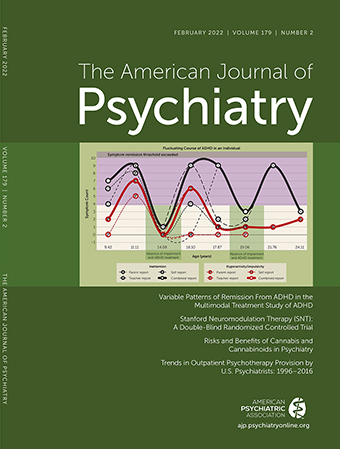As the four-decade long overdose crisis enters its “fourth wave”— characterized by polysubstance use of potent, illicitly manufactured synthetic opioids, psychostimulants, and other drugs (
1–
4)—renewed attention is warranted to trends stratified by race and ethnicity. Although in recent years the drug crisis has been largely portrayed as a “White problem,” this narrative has never accounted for evident racial disparities (
5,
6). New data paint a stark picture of worsening burden of overdose on minoritized communities (
7).
Using records from the National Vital Statistics System, we examined drug-related overdose mortality per 100,000 people separately by race/ethnicity, state, and type of drugs involved from 1999 to 2019 (see methods in
online supplement for more details). For state-years where comparisons could be made, the rate for each racial/ethnic group was compared with that of non-Hispanic White individuals as a ratio.
Overdose mortality per capita among non-Hispanic Black individuals more than tripled between 2010 and 2019, compared with a 58% increase among non-Hispanic Whites during the same period (
Figure 1). In 2010, non-Hispanic Black individuals had an overdose mortality rate that was 0.50 times that of non-Hispanic Whites. Yet by 2019 the ratio had surged to 0.99 (
Figure 2). In 2010, the Black-White overdose mortality ratio was above 1.0 in only N=5 (13.5%) of 37 states with sufficient population size for comparisons. However, by 2019, Black mortality exceeded that of White individuals in 23 (57.5%) of the 40 states covered (
Figure 2). These shifts were largely driven by elevated rates of overdose involving fentanyl and its analogs (with a Black-White ratio in 2019 of 1.13), heroin (1.07), and cocaine (2.50).
Overdose rates among non-Hispanic American Indian or Alaska Native (AI/AN) individuals rose from 1.03 times that of White individuals in 2010, to 1.15 in 2019. Increases in methamphetamine-related overdose represented the largest component of the increase, rising over eightfold between 2010 and 2019 to reach 12.30 per 100,000 people. In 2019, the AI/AN-White overdose mortality ratio was above 1.0 in N=18 (85.7%) of 21 states where comparisons could be made.
Distinct age and sex patterns can be observed by race/ethnicity (see
figure 1 in the
online supplement). Among males, the highest observed race/ethnicity- and age-specific total overdose death rates were observed among non-Hispanic Black men 55–59 years of age. Their rate of 89.5 deaths per 100,000 represented nearly double the rate of non-Hispanic White individuals of the same age. Conversely, the highest total overdose death rates among non-Hispanic White men were observed in the 35–39 years age category, with 74.3 deaths per 100,000. This represented 23.5% higher than non-Hispanic Black Men of the same age. The Black-White overdose death gap is therefore distinct for younger and older men. Yet the disparities between older Black and White men are the largest magnitude. This drives an average trend of higher overdose mortality for Black men relative to their White counterparts in both age-standardized and population-weighted terms. Among women, the highest total overdose rates were observed among American Indian and Alaska Native women 35–39 years of age, with 55.1 deaths per 100,000. This represented a death rate 56.5% higher than that of non-Hispanic White women of the same age.
The data presented here should be interpreted in the context of limitations affecting overdose surveillance in the United States. Quality of reporting is known to vary between states, and race/ethnicity may be incorrectly assigned for some deaths, especially among American Indian and Alaska Native populations (
8). Although clear trends can be observed at the national level, caution is warranted in interpreting specific state and race/ethnicity-specific findings, given potential for variability in quality and reporting standards.
These trends are particularly concerning given that the COVID-19 pandemic has drastically exacerbated overdose mortality in the United States (
9). Recent surges are likely to widen racial/ethnic overdose disparities (
5,
7,
10). Troublingly, provisional CDC overdose mortality reports and modeling efforts documenting recent trends contain no information about race or ethnicity (
11,
12). This impedes timely surveillance of disparities in overdose and delays efforts to address them.
As the nation grapples with the fallout from the COVID-19 pandemic, racial disparities have gained increased research and policy attention (
13,
14). Similarly, rapidly surging overdose burden among Black and American Indian and Alaska Native communities must be understood as a symptom of structural racism (
13). This includes discriminatory criminal laws and their inequitable enforcement by police, as well as systematic barriers in access to healthcare. This has resulted in a landscape of decreased substance use treatment initiation and engagement (
15) and poor access to addiction specialists, especially from underrepresented minority backgrounds (
16). Additional upstream drivers of overdose include gaps in education, employment, and access to medical care. The pandemic has deepened many of these inequalities, as communities of color have been disproportionately affected by disruptions to schooling and employment and healthcare, in particular (
17,
18). These shifts necessitate centering an antiracist approach in the national response to the growing overdose crisis, during the pandemic and postpandemic recovery period.



